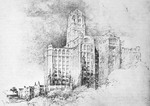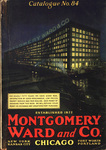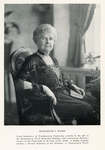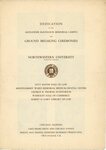Introduction
In its 166-year history, the Feinberg School of Medicine has had four names, five locations, and an evolving relationship with Northwestern University. From its founding as part of another university in 1859 to being fully integrated into Northwestern in 1906, the medical school, as well as Northwestern’s other professional schools, have always been physically separate from the university while still trying to maintain a sense of connection with the Evanston campus and each other. In the 1920s, Northwestern embarked on one of its largest-ever projects: combining the professional schools on a new campus.
Credits
Curated and designed by Emma Florio, MLIS, Archives & Research Specialist, with support from Katie Lattal, MA, Special Collections Librarian, and Emma Wilson, Communications Coordinator.
The medical school’s fourth location contained a clinical amphitheater, a lecture hall, and laboratories that were equipped to give students a strong foundation in the basic sciences. A dispensary building was quickly added to house the school’s free clinics. Within 20 years, though, the school had outgrown the buildings and was looking at options to expand onto adjacent land.
The other professional schools (Dental, Law, and Commerce) were outgrowing their shared building as well. By the 1910s, University leadership were discussing bringing these schools together on a single campus, to reduce long term expenditures and to create a stronger university spirit. One prominent trustee wanted them all moved to Evanston. The Dean of the Law School preferred being near the Criminal Courts. They would eventually settle for a stretch of land north of the Loop named for the eccentric squatter who had illegally claimed it for decades.
The announcement for the medical school’s 1907-08 school year (above) describes the many facilities available to students, including in the Department of Physiology. Images below are from 1901 and 1906 announcements.
Source: Quarterly Bulletin of Northwestern University Medical School 9, no. 1 (June 1907); 3, no. 1(June 1901); 8, no. 1 (June 1906).
The medical school spent most of its first 67 years on the Near South Side, close to the homes of some of the city’s wealthiest residents. By the 1890s, though, industry, railroads, and public transit were encroaching on the area, bringing pollution and congestion. As the wealthy moved north to what became the Gold Coast, European immigrants and African American migrants from the South came to the area in search of jobs. While this changing racial and socioeconomic makeup was never an explicit reason for the school to move north, leadership did acknowledge that it would affect the type of patients who visited the school’s free clinics. They anticipated fewer Black patients and more of the city’s growing population of immigrants in their new location.
As early as 1908, Northwestern’s business manager William Dyche had suggested moving the professional schools to an undeveloped area a few blocks north of the Chicago River. A squatter named George Streeter had occupied the land for almost 20 years and had been illegally selling parcels to unsuspecting buyers while fighting off the legal landowners. After years of battles, both legal and physical, Streeter’s settlement was finally removed in 1918. In an ironic twist of fate, the area would be named Streeterville after the infamous former resident whom the city sought to remove for so long.
Police attempted to evict Streeter from the land numerous times, including in 1902, as seen in these photos. (Above left) Police destroy the shack where Streeter lived. (Above right) Streeter (seated with top hat) sits with his wife outside of the tent he used during these eviction battles.
Sources: (l) “Deputy Sheriffs and Police Raze Streeter’s Shanty,” Chicago Tribune, August 13, 1902. (r) Ballard, E. G., Captain Streeter, Pioneer (Chicago: Emery Publishing Service, 1914), facing 160.
(Right) This view of the future Chicago Campus, looking north from Superior Street east of Fairbanks Court, was taken at the time of purchase in 1920. The National Guard armory in the upper left was demolished in 1993 to make way for the Museum of Contemporary Art.
Source: Print mockup for Arey, Leslie B. Northwestern University Medical School, 1859-1979: A Pioneer in Educational Reform. Evanston, IL: Northwestern University, 1979.
(Left) A bridge extending Michigan Avenue across the Chicago River had long been proposed by city planners as a way to further develop the area north of the river and connect it to the city’s business center. This circa 1918 rendering, looking north across the river, shows one of the more grandiose proposals for the “most important link between the downtown ‘loop’ section and the foremost residential district of Chicago.”
Source: Chicago’s Reconstruction Plan (Chicago: Frank J. Campbell, 1919), 93. Drawing by A. N. Rebori.
In 1915, attorney and University Trustee Nathan William MacChesney took up the cause of the Chicago Campus and used his force of will to push the project forward. In a memo to his fellow Trustees, he laid out the reasons why this location was desirable. Land there was cheaper than in the business center of the Loop, while still being within walking distance. A planned Michigan Avenue bridge (opened in 1920) would further connect the area to the Loop, making it even more desirable over time. Plus, there was no competition from other major universities. The University of Chicago dominated the South Side and the University of Illinois the West Side, leaving the North Side unoccupied educational territory.
Over the next two years, MacChesney met with the Deans of the professional schools to formulate plans for their new buildings. He was torn; despite general approval of the project by university administration—the Trustees, the President, and the Deans—there was no definitive plan to move forward. He knew the land in Streeterville was the perfect opportunity for the Chicago Campus, but felt he might be pushing his agenda too forcefully. In early 1917, MacChesney sent a letter to Arthur Kendall, the Dean of the medical school, urging Kendall to rally the medical faculty to support the new campus project.
…now is the time to act. We have the only ground available definitely within our control for the next sixty days… If we could only settle our various difficulties and put everybody in a position to act, I believe that we could realize the ideal we have in mind.
Nathan MacChesney to Arthur Kendall, February 12, 1917
Fifty-three days later, the United States entered the First World War.
MacChesney used his connections to keep Northwestern’s option on the land through the duration of World War I. He used those same connections with the area’s wealthy residents to raise enough money to finally purchase nine acres in June 1920, seen as an empty lot (1) in the above photo from 1924, one year before groundbreaking.
Source: Northwestern University Alumni News 4, no. 1 (November 1924).
In a 1923 issue of the Alumni News (right), MacChesney tells the story of how the land was selected for the Chicago Campus. Throughout his tenure as Alumni President, he used the Alumni News to advocate and fundraise for the Chicago Campus and other improvements that made up the so-called “Greater Northwestern” plan. This constant promotion of MacChesney’s prized project proved to be highly successful, raising millions of dollars from alumni.
Source: Northwestern University Alumni News 2, no. 7 (May 1923).
MacChesney continued his close association with the Chicago Campus project as President of Northwestern University Alumni Association in the crucial fundraising years of 1922-24, and it was under his tenure that the campus became the focal point of a greater university capital campaign. In that same period, he became general counsel for the National Association of Real Estate Boards (NAREB). It is important to note that, in his work for NAREB, he wrote the “Standard Form, Restrictive Covenant” in 1927, which allowed homeowners to prohibit the sale of property to African Americans. This codified racial segregation in Chicago and many American cities for decades.
In 1910, the Carnegie Foundation for the Advancement of Teaching published a study of the conditions and efficacy of North America’s 155 medical schools, known as the Flexner Report. Educator Abraham Flexner had visited each of the schools and was appalled by the lack of consistency he found in their curricula, facilities, and requirements for admission and graduation. On top of that, coursework often did not reflect the state of modern science-based medicine, which emphasized research and experimentation.
By the early 1900s, modern medicine had made many advances, including more effective treatment of acute illnesses and improved public health initiatives. This work required expensive, well-staffed research labs and clinics where students could encounter disease first-hand. Flexner believed that funding for these facilities should come from the public, fulfilling their half of an implicit social contract: society needed well-trained doctors and, in order to provide an excellent education for those doctors, society must support their schools.
This social contract originated in the ideals of the Progressive Era (1890s-1920s), when activists worked to improve the human condition through political reform and with a faith that science and empirical data could solve society’s problems. As medicine was professionalizing, large-scale public health emergencies arose due to crowded tenements and slums, industrial health hazards, and tainted food and medicines, necessitating sweeping changes to protect the public. A tradition of philanthropy developed to fund crucial reforms in areas where the government had not intervened. Drawing on progressive ideas, Flexner turned medical education reform into a social movement all its own.
Progressive reforms included regulating child labor and requiring mandatory education, and the introduction of the settlement house movement. Starting in America with Chicago’s Hull House, settlement houses worked with recently arrived immigrants in an effort to provide education and community.
Source: (top right) Hine, Lewis W. [Children working in a textile mill in Macon, Georgia]. January 19, 1909. National Child Labor Committee Collection, Library of Congress, Prints and Photographs Division. (bottom right) “A Children’s Class in the Music School,” Hull-House Year Book (Chicago: Hull House, 1921), 16.
Courses at Northwestern did reflect some of the scientific advancements of the day. Students in this clinical pathology lab (below), at the school’s fourth location at 24th & Dearborn, circa 1903, used microscopes and other instruments to learn how to diagnose disease through the analysis of bodily fluids and tissues. When Flexner visited in 1909, he found the laboratory facilities well equipped but lacking the proper staffing.
Instruments like this capillary microscope (above), which was used to observe capillary action noninvasively by focusing on the nail fold of the finger, were developed with the help of medical researchers in the early 20th century. This 1926 Bausch and Lomb microscope comes from Northwestern University Dental School.
Northwestern was the first medical school in the country to have its own diet kitchen, installed in the dispensary in 1903. Diet kitchens, which were more prevalent in hospitals, provided patients and outpatient visitors—most often children—with specialized, nutritious meals prepared in sterile environments. In this way, they promoted the Progressive Era ideals of pure and safe food and assistance to needy families. In this circa 1906 photo (right), nurses prepare milk for infants in Northwestern’s diet kitchen.
(Above) This circa 1923 fundraising pamphlet emphasizes how much modern scientific medicine had accomplished in terms of combating disease, and how Northwestern had already contributed to this medical progress. But there was still much to do, and Northwestern could help do it, with the facilities that the Flexner Report made an imperative for success. Northwestern leadership hoped to tap into the Progressive-era spirit of philanthropy to raise money for its new building, imaginatively rendered on the cover, from a national network of alumni as well as Chicago’s wealthiest residents.
Source: Northwestern University. The Last Battlegrounds of Disease. Evanston, IL: Northwestern University, c. 1923.
The Flexner Report made sweeping and aggressive recommendations to improve North America’s medical education system: 80% of the country’s medical schools were inadequate and should be closed—including 15 of Chicago’s 18 schools. Flexner deemed Northwestern one of the three Chicago schools worthy of survival, although it still had work to do in terms of entrance requirements and the quality of the student body. The other two were Rush Medical College and the College of Physicians and Surgeons (now the University of Illinois College of Medicine). By the 1930s, 60% of the country’s schools had closed or been merged into universities.
“That [Northwestern] will be driven by internal and external forces to a higher level, actually enforced, is inevitable.”
Abraham Flexner, Medical Education in the United States and Canada, 217
(Right) Entry for Northwestern University Medical School in the Flexner Report.
Source: Flexner, Abraham. Medical Education in the United States and Canada... (New York: Carnegie Foundation, 1910), 208.
A series of campaigns began in 1919 to raise funds for the realization of a “Greater Northwestern,” a plan which included the Chicago Campus, building projects in Evanston, and an enlargement of the university’s endowment. By 1921, the school had bought the land in Streeterville and received a pledge from the McKinlock family to name the future campus in memory of their son, George Alexander McKinlock, Jr., who was killed in service during World War I. Within 10 years, however, the hardships of the Great Depression prevented them from fulfilling that pledge. By the mid 1930s, the Trustees had ended the arrangement, returned the McKinlocks’ money, and removed the name.
Northwestern’s 1922 campaign hoped to raise $4.5 million, with $2.4 million going to the Chicago Campus. The new president, Walter Dill Scott, was an expert in the psychology of advertising, and created a marketing strategy aimed at both alumni and wealthy Chicagoans. It was a success: funds raised in 1923 more than doubled all the gifts that Northwestern had ever received. By early 1924, the campaign had raised almost twice the target goal—$8.5 million ($155 million today), with $7 million of that intended for the Chicago Campus. (Right) A fundraising advertisement from an earlier campaign.
Source: Alumni Journal, Northwestern University Bulletin 20, no. 32 (February 1920).
As part of his marketing strategy, President Scott commissioned renderings of the ideal Chicago Campus to demonstrate the importance and beauty of the project. Architectural firm Holabird & Roche—pioneers of the Chicago skyscraper—created ornate designs like the one seen above, which ultimately were not chosen.
Source: Northwestern University Alumni News 1, no. 5 (March 1922).
More than half of the money for the Chicago Campus came from one person: Elizabeth Ward, the widow of Chicago mail-order tycoon A. Montgomery Ward. Between December 1923 and January 1924, she gave $4 million ($73 million today) to construct the medical school’s new home in Streeterville. At the time, it was the largest gift made by a living donor in Chicago history and one of the largest single donations ever received by an American university. She later gave another $4 million to endow the medical school’s work.
(At right) The Alumni News article announcing Mrs. Ward’s gift included a rendering of the future Ward building by James Gamble Rogers, an architect known for his Collegiate Gothic style who was chosen to design the campus. In the caption are Mrs. Ward’s three stipulations for the building that would act as a memorial to her husband: "It must be a visible thing which adds something to the values of the city. It must be enduring. It must be useful to humanity."
Source: Northwestern University Alumni News 3, no. 3 (January 1924).
Aaron Montgomery Ward founded the world’s first mail-order retail company in Chicago in 1872. Within 50 years it was one of America’s top retailers, with sales over $100 million (nearly $1.9 billion today). Ward is also notable for his fight to preserve the Lake Michigan shoreline as a public park—often in conflict with his fellow barons of industry—which led to the creation of Grant Park. He died in 1913, leaving a $15 million fortune (about $476 million today) for his wife to disburse how she saw fit.
Source: [Cover.] Catalogue. No. 84. Chicago: Montgomery Ward & Co., 1915.
Early milestone celebrations for the Ward Memorial Building always highlighted Mrs. Ward, whose generous donation made the building possible. Her portrait (right) was featured in a place of prominence in the program commemorating the 1927 dedication of the building.
Source: Northwestern University. Dedication of the Montgomery Ward Memorial Building... Chicago: Lakeside Press, 1929.
Groundbreaking for the Ward Memorial Building (and the other buildings of the Chicago Campus) took place 100 years ago, on May 8, 1925. The ceremony, commemorated with this program (above left), was presided over by the Chicago Campus’s longtime champion, Nathan MacChesney. Major donors for all of the buildings attended and each dug a ceremonial shovel of dirt, including Mrs. Ward, as seen in the photo (above right).
Over the next year, the world’s first academic skyscraper would be built. The cornerstone was laid on June 11, 1926, and the first classes to be held in the Ward Building began on October 1 that year. A future exhibit will continue the story of the Chicago Campus after the 1925 groundbreaking.
Primary Sources
- [Aerial view of Streeterville and surrounding area]. Northwestern University Alumni News 4, no. 1 (November 1924): 18-19. https://babel.hathitrust.org/cgi/pt?id=ien.35556027642602&seq=24
- “Backwards and Forwards.” Northwestern University Alumni News 1, no. 5 (March 1922). https://babel.hathitrust.org/cgi/pt?id=ien.35556027642578&seq=107&view=1up
- Chicago’s Reconstruction Plan. Chicago: Frank J. Campbell, 1919. https://archive.org/details/chicagosreconstr00camp/
- Dyche, William A. “Northwestern University in Chicago: Development of the Chicago Campus.” Northwestern University Alumni News 2, no. 4 (February 1923): 15-17. https://babel.hathitrust.org/cgi/pt?id=ien.35556027642586&seq=99&q1=campus&start=1
- Hull-House Year Book. Chicago: Hull House, 1921. https://archive.org/details/hullhouse1921hull/page/n1/mode/2up
- MacChesney, Nathan William. “The Genesis and History of Northwestern University Downtown Campus.” Northwestern University Alumni News 2, no. 7 (May 1923): 3-6. https://babel.hathitrust.org/cgi/pt?id=ien.35556027642586&seq=172&q1=campus&start=1
- “Making Ready for $25,000,000.” Alumni Journal, Northwestern University Bulletin 20, no. 29 (February 7, 1920): 3-7. https://babel.hathitrust.org/cgi/pt?id=ien.35556027642495&seq=345&q1=campus&start=2
- Montgomery Ward & Company. Catalogue No. 84. Chicago: Montgomery Ward & Co., 1915. https://archive.org/details/MontgomeryWard1916/mode/2up
- “Mrs. Montgomery Ward Gives $3,000,000 Memorial.” Northwestern University Alumni News 3, no. 3 (January 1924): 5-6. https://babel.hathitrust.org/cgi/pt?id=ien.35556027642594&seq=86
- Nathan William MacChesney Papers, 1/10. Northwestern University Archives. Evanston, Illinois. https://findingaids.library.northwestern.edu/repositories/6/resources/1119
- National Child Labor Committee Collection. Library of Congress, Prints and Photographs Division. https://www.loc.gov/pictures/collection/nclc/
- [Notice for "Greater Northwestern" fundraising program]. Alumni Journal, Northwestern University Bulletin 20, no. 32 (February 1920). https://babel.hathitrust.org/cgi/pt?id=ien.35556027642495&seq=342&q1=%22ten+year+program%22
- Northwestern University. Dedication of the Montgomery Ward Memorial Building, Northwestern University Medical School, Alexander McKinlock Memorial Campus, Chicago. Chicago: Lakeside Press, 1929.
- Northwestern University. The Last Battlegrounds of Disease. Evanston, IL: Northwestern University, c. 1923.
- Northwestern University. Quarterly Bulletin of Northwestern University Medical School. Chicago: Northwestern University Medical School.
- “Purchase of the Chicago Campus.” Alumni Journal, Northwestern University Bulletin 21, no. 22 (November 27, 1920): 15-16. https://babel.hathitrust.org/cgi/pt?id=ien.35556027642495&seq=459&q1=campus&start=3
- Walter Dill Scott (1869-1955) Papers, 3/15/1. Northwestern University Archives. Evanston, Illinois. https://findingaids.library.northwestern.edu/repositories/6/resources/500
- William Andrew Dyche (1861-1936) Papers, 7/1/5. Northwestern University Archives. Evanston, Illinois. https://findingaids.library.northwestern.edu/repositories/6/resources/1046
Secondary Sources
- “1886—Streeterville.” Chicagology. 2025. https://chicagology.com/notorious-chicago/streeterville/
- Arey, Leslie B. Northwestern University Medical School, 1859-1979: A Pioneer in Educational Reform. Evanston, IL: Northwestern University, 1979. https://prism.northwestern.edu/records/aet3x-ywc13
- Ballard, Everett Guy. Captain Streeter, Pioneer. Chicago: Emery Publishing Service, 1914. https://archive.org/details/captainstreeterp00ball/captainstreeterp00ball/
- “A Brief History of Deed Restrictions and Restrictive Covenants.” Chicago Covenants. https://www.chicagocovenants.com/history
- Davidson, Michael W. “Bausch & Lomb Capillary Microscope.” Molecular Expressions: Optical Microscopy Primer. Florida State University Museum of Microscopy, 2015. https://micro.magnet.fsu.edu/primer/museum/bauschcapillary.html
- Flexner, Abraham. Medical Education in the United States and Canada: A Report to the Carnegie Foundation for the Advancement of Teaching. New York: Carnegie Foundation, 1910. http://archive.carnegiefoundation.org/publications/pdfs/elibrary/Carnegie_Flexner_Report.pdf
- Hirsch, Arnold R. “Restrictive Covenants.” Encyclopedia of Chicago. Chicago Historical Society, 2005. http://www.encyclopedia.chicagohistory.org/pages/1067.html
- Ludmerer, Kenneth M. “Commentary: Understanding the Flexner report.” Academic Medicine 85, no. 2 (February 2010): 193-196. https://doi.org/10.1097/ACM.0b013e3181c8f1e7
- Ludmerer, Kenneth M. Time to Heal: American Medical Education from the Turn of the Century to the Era of Managed Care. New York: Oxford University Press,1999.
- McClendon, Dennis. “Near South Side.” Encyclopedia of Chicago. Chicago Historical Society, 2005. http://www.encyclopedia.chicagohistory.org/pages/877.html
- Northwestern University. A Pictorial History of Northwestern University: 1851-1951. Evanston, IL: Northwestern University, 1951.
- Wade, Louise Carroll. “Settlement Houses.” Encyclopedia of Chicago. Chicago Historical Society, 2005. http://www.encyclopedia.chicagohistory.org/pages/1135.html
- Ward, Estelle Frances. The Story of Northwestern University. New York: Dodd, Mead and Company, 1924.
- Williamson, Harold F. Northwestern University: A History, 1850-1975. Evanston, IL: Northwestern University, 1976.
- Wilson, Mark R. “Ward (Montgomery) & Co.” Dictionary of Leading Chicago Businesses (1820-2000). http://www.encyclopedia.chicagohistory.org/pages/2895.html
Exhibit Details
In commemoration of the 100th anniversary of the groundbreaking of the Feinberg School of Medicine’s Ward building (May 8, 1925), this exhibit explores the story of the medical school’s move to Streeterville, including its former locations, the decision to move, the world of medical education and progress in the early 20th century, and the financial campaigns that raised millions to create the Chicago Campus.
-
- Location
- Eckenhoff Reading Room
- Date
- May 1, 2025 - Oct 6, 2025
- Contact
- ghsl-specialcollections@northwestern.edu
- Subjects
- northwestern
- chicago
- 20th century
- medical education
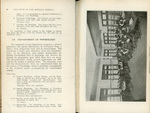

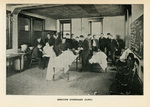

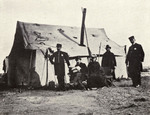


.jpg)
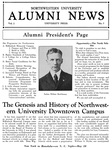
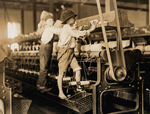.jpg)
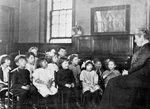%20(IA).jpg)
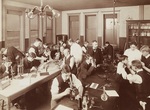


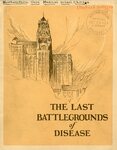

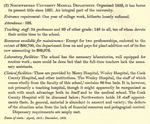
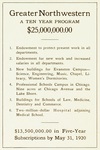.jpg)
.jpg)
